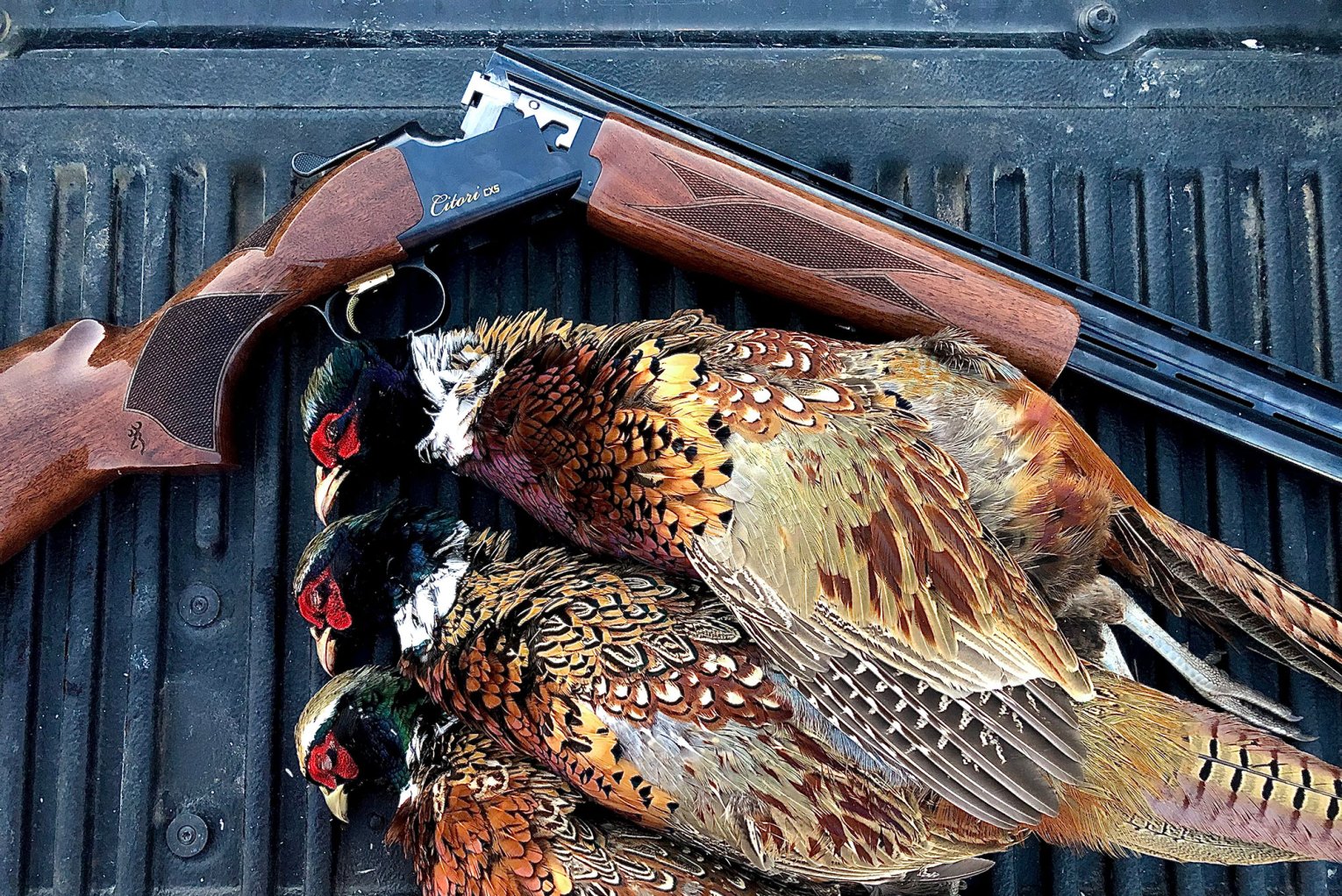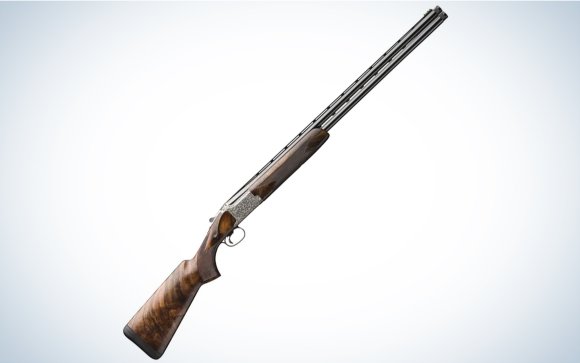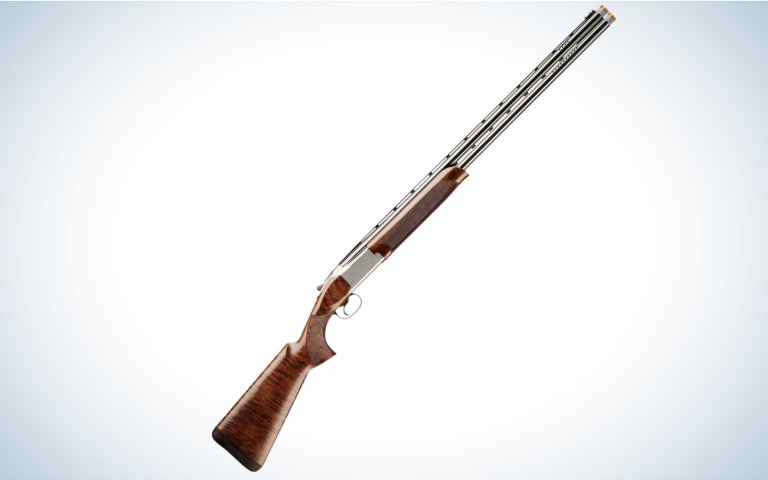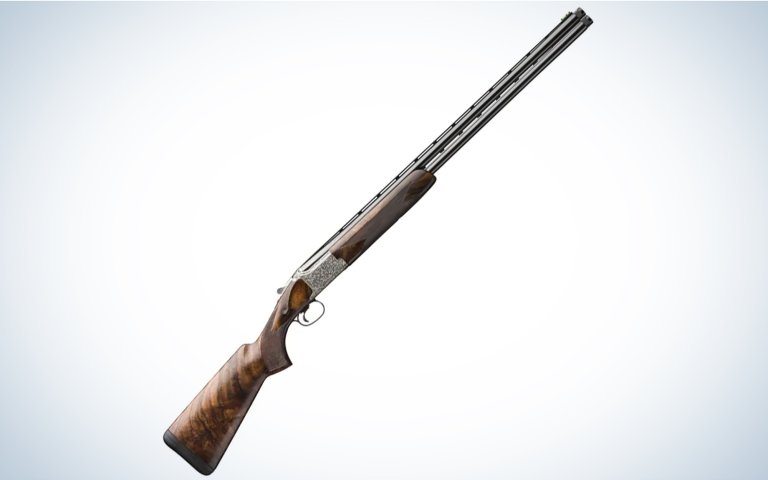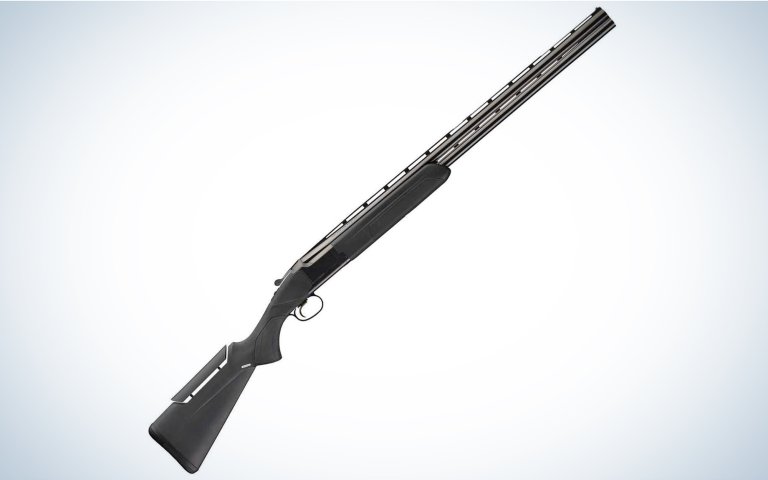We may earn revenue from the products available on this page and participate in affiliate programs. Learn More ›
There are more than 100 different models of the Browning Citori. The over/under shotgun debuted in the early 1970s as a more affordable option to John Moses Browning’s final firearm design, the Browning Superposed. The Citori is the most successful over/under in American history with more than 2 million sold. The sheer number of variants makes choosing the best Browning Citori a complicated task. Because when you get down to it, just about every Citori is the same. They are all built on the same boxlock action, though some are lighter or heavier than others. Some have longer or shorter barrels and some have ported barrels. Most older models have fixed chokes and modern ones have screw-in chokes. You get the idea.
However, a select few Citoris do stand out above the rest. On paper, these shotguns only have slight differences when compared to the many models Browning has produced over the last 50-plus years. But veteran hunters and clay shooters know that small refinements to a shotgun can result in improved accuracy. So those differences aren’t so slight to those of us with a keen eye. And, if you’re a gun collector, the craftsmanship, ornate engravings on the receiver, and polish of the high-grade walnut may draw more appeal. This year Browning is celebrating 50 years of the Citori with two new models that are vastly different: a high-grade special edition and a workaday composite version. No matter what features you find most desirable in an over/under, there’s likely a Citori made to your liking.
- Best for Hunting: Browning Citori Hunter Grade I
- Best Field Model: Browning Citori Feather Lightning
- Best for Clays: Browning Citori 725 Sporting
- Best Hunting/Clays Crossover: Browning Citori CX
- Best for Gun Collectors: Browning Citori High Grade 50th Anniversary
- Browning Citori Composite
How I Picked the Best Browning Citoris

I’ll admit that I have not shot every Citori variant in existence, but I have handled many of them, both in the field and on the skeet range. Much like every other shotgun line in history, there has been an evolution of the Citori since it was introduced in the early 1970s. For instance, today’s 725 series is a step above the older 425, 525, and 625 models in fit, finish, and overall shootability. The same can be said for the Hunter lineup of Citoris.
Over time, the engineers at Browning and the Miroku factory in Japan where the guns are made, have improved the Citori’s functionality and aesthetic beauty. That’s why many of the modern versions of this gun are best—though an “old” or pre-owned Citori is not a poor choice. They are all fine shotguns that shoot straight, and rarely break down, but only a handful are among the best Citoris.
Best for Hunting: Browning Citori Hunter Grade I
Best for Hunting
Browning Citori Hunter Grade I
See ItKey Features
- Gauge: 12, 20, 28, .410
- Action: Boxlock O/U
- Capacity: Two
- Chamber: 3-inch; 2 -inch (28-gauge only)
- Barrel Type: Chrome-lined steel
- Barrel Length: 26 or 28 inches
- Chokes: IC, M, F (Invector-Plus: 12- and 20-gauge; Invector: 28-gauge and .410)
- Sights: Silver bead front
- LOP: 14¼ inches
- Weight: 6 pounds, 14 ounces to 7 pounds, 11 ounces
- Cost: $2,180 to $2,250
The Citori Hunter Grade I 12-gauge retails for less than $1,900, making it one of the best over/under shotguns on the market for the money.
It’s a fairly standard break-action shotgun with no engraving on the receiver.
Because of its ease of use, reliability, and low cost, this Citori is often the O/U many American hunters start with. For a do-all break-action shotgun, you’re not going to find a better option than the Hunter.
It’s available in four gauges—12, 20, 28, and .410-bore (26- or 28-inch barrels)—and can be used for just about any kind of small game or bird hunting pursuit. I had an older model of the Hunter more than a decade ago and killed everything from squirrels to Canada geese with it, though I would not suggest regularly shooting 3-inch, 1⅝-ounce waterfowl loads through any Citori—the recoil will rattle you to the bone.
It’s not uncommon to see turkey hunters in the woods with the 12- and 20-gauge or even .410-bore (where legal). Turkey payloads are stout and can punish your shoulder, but you’re only shooting once (hopefully). The Hunter also delivers an even 50/50 pattern from either barrel—ideal for connecting on a longbeard, or any game for that matter. The only thing that ended up separating me from my first Citori was its weight. The 12-gauge is nearly 8 pounds, and after one too many long slogs chasing rabbits through a muddy field, I ended up selling it and bought an Italian-made 20-gauge auto-loader.
Best Field Model: Browning Citori Feather Lightning
Best Field Model
Browning Citori Feather Lightning
See ItPros
- Lightweight alloy receiver takes almost a full pound out of the 12-gauge Feather Lightning in comparison to the Hunter Grade I, making it more manageable to carry afield.
Cons
- A drop in shotgun weight can have a negative effect on accuracy, and you will certainly experience more felt recoil.
Key Features
- Gauge: 12, 20
- Action: Boxlock O/U
- Capacity: Two
- Chamber: 3-inch
- Barrel Type: Chrome-lined steel
- Barrel Length: 26 or 28 inches
- Chokes: Invector Plus (IC, M, F)
- Sights: Silver bead front
- LOP: 14¼ inches
- Weight: 5 pounds, 13 ounces to 7 pounds, 2 ounces
- Cost: $3,180
When I ditched the 12-gauge Citori Hunter because of its weight, I wish I would have considered the Feather Lightning before making the transition to a 20-gauge autoloader. In fact, the 26-inch barrel, 20-gauge version of the Feather Lightning weighs less (5 pounds, 13 ounces) than any shotgun in my safe that’s not a .410. It’s true that a lighter shotgun can be difficult to shoot because less weight makes it harder to hold steady on stationary targets or maintain your swing on moving targets. But since most Citoris are barrel-heavy (this one included) there will be less of an adjustment for hunters transitioning from an 8-pound over/under to the Feather Lightning. Plus a 6-pound gun is far more enjoyable to carry.
Browning kept the weight down by building this Citori variant with an alloy receiver, though the breech face and hinge pin are both steel. The receiver has intricate floral engraving on each side, plus the oil finished American walnut is of a higher grade (III/IV) than that on the Hunter. Polished, blued barrels are available in 26 or 28 inches with IC, M, and F extended Invector Plus chokes.
Like all Citori 20 and 12 gauges, the Feather Lightning was designed with Browning’s Total Barrel Dynamics. This includes their Vector Pro process, which is a gradual tapering of the forcing cones into the barrel that compliment Invector Plus and DS chokes. The barrels are also overbored, a process that enlarges the bore to its maximum diameter, which can result in improved patterns. In fact, after extensive testing, Field & Stream Shooting Editor Bob Brister—one of the best live pigeon shots of all time—had many of his shotguns overbored for this very reason.
Best for Clays: Browning Citori 725 Sporting
Best for Clays
Browning Citori 725 Sporting
See ItPros
- Browning’s premium Invector DS chokes are available in the 12- and 20-gauge.
Cons
- No system to add or remove weight from the gun and alter its overall balance.
Key Features
- Gauge: 12, 20, 28, .410
- Action: Boxlock O/U
- Capacity: Two
- Chamber: 3-inch; 2¾-inch (28-gauge only)
- Barrel Type: Chrome-lined steel
- Barrel Length: 30 or 32 inches
- Chokes: Extended SK, IC, M, IM, F (Invector DS: 12- and 20-gauge; Invector: 28-gauge and .410)
- Sights: HivViz Pro Comp front sight
- LOP: 14¾ inches
- Weight: 7 pounds, 5 ounces to 7 pounds, 10 unces
- Cost: $3,530 to $3,600
The 725 lineup is its own branch of the Browning Citori series. Offered in a myriad of field, clays, and trap models, the 725s are built with a lower profile receiver than other Citoris to make target acquisition easier on the shooter. If I were to buy a Citori today it would be a 725, but not because of the sight picture it offers. They are simply less cumbersome shotguns that swing exactly how you want them to. The other Citoris are a bit blocky, and though they are not a burden to handle, the feel of the 725s suits me better. You may find the opposite to be true. Each shooter has different preferences, after all.
With the 725, you also get top-of-the-line Invector DS (double seal) chokes. The goal of the DS system is to ensure that propellant gasses from the shotshell exit through the choke only, and don’t intrude between the choke and barrel wall. This design makes it easier to remove the choke for cleaning. They also have a larger pattern difference than competitors’ chokes as you move from one constriction to another, according to Browning. I can’t confirm that claim, but I have seen DS chokes perform well on the pattern board.
During our best duck hunting shotgun test, the Browning A5, which uses DS chokes, placed 116 of a possible 140 steel No. 2s (82 percent) inside a 30-inch target from 35 yards, one of the best results of the week. Browning incorporated a mechanical trigger into the 725s as well so if the first shot does not go off the second round can still be fired, giving you a chance to break the target.
Best Hunting/Clays Crossover: Browning Citori CX
Best Hunting/Clays Crossover
Browning Citori CX
See ItPros
- The Citori CX is designed for hunters who also shoot clays, but don’t want to spend the extra money on a dedicated clays gun.
Cons
- If you choose the 32-inch barrels, this gun weighs 8.5 pounds unloaded. That’s a lot of wood and steel to carry afield.
Key Features
- Gauge: 12
- Action: Boxlock O/U
- Capacity: Two
- Chamber: 3-inch
- Barrel Type: Chrome-lined steel
- Barrel Length: 28, 30, or 32 inches
- Chokes: Extended Invector-Plus (IC, M, F)
- Sights: Mid bead, Ivory bead front sight
- LOP: 14¼ inches
- Weight: 8 pounds, 1 ounce to 8 pounds, 5 ounces
- Cost: $2,480
Truthfully, just about any over/under can serve as a dual-purpose clays and hunting shotgun, but the Citori CX was designed specifically for those who enjoy both pursuits. It’s a heavy break-action, tipping the scales at over 8 pounds. That’s good for clays but not many of us want to lug that much weight during a long day in the field. Luckily, the gun is well balanced, so it’s not as much of a burden to haul around the uplands. Just don’t go chasing mountain chukar with the CX unless you’re built like Paul Bunyan.
Browning’s Triple Trigger system (found on many modern Citoris) allows you to choose from three different trigger shoe profiles to find a comfortable position. There are also three extended Invector-Plus chokes (IC, M, F) though it would be nice if Browning added SK and IM as standard since this is a gun for clays and hunting. For instance, shooting skeet with an IC and M choke is not ideal, and there are times an IM tube would be handy for late-season roosters or Canada geese. Browning does sell its chokes separately, so you can pay a little extra, for additional chokes. Lengthened forcing cones and back-bored barrels are also included in the CX.
Best for Gun Collectors: Browning Citori High Grade 50th Anniversary
Best for Gun Collectors
Browning Citori High Grade 50th Anniversary
See ItPros
- Extensive receiver engraving, plus grade IV Turkish walnut stock and fore-end with gloss oil finish.
Cons
- Inertia trigger. When you’re paying over $8,000 for a break-action it would be nice to have a mechanical trigger.
Key Features
- Gauge: 12
- Action: Boxlock O/U
- Capacity: Two
- Chamber: 3-inch
- Barrel Type: Chrome-lined steel
- Barrel Length: 30 or 32 inches
- Chokes: Extended Invector Plus (SK, IC, M, IM, F)
- Sights: Ivory mid-bead, HivViz Pro Comp front
- LOP: 14¾ inches
- Weight: 7 pounds, 15 ounces-8 pounds, 1 ounce
- Cost: $8,400
If your passion is shooting beautiful shotguns, then the Citori High Grade 50th anniversary edition is the perfect choice. Unlike standard Citoris, this over/under features a Turkish walnut stock, that includes a nameplate inlay for the owner’s initials, and fore-end (most Citoris use American walnut). The floral engraving on the silver nitrate steel receiver also features a gold “50 Years 1973-2023” inlay on the underside of the receiver. There is more floral engraving work on the trigger guard and fore-end release latch.
Every upgrade that Browning offers in the Citori—with the exception of mechanical triggers and an adjustable comb—is built into the 50th anniversary edition. Barrels, available in 30- or 32-inch options, are back bored and Browning used its Vector Pro forcing cone lengthening process to optimize patterns downrange. Longer forcing cones gently transition shotshell pellets as they travel from the chamber through the barrel and exit the muzzle so that they experience less deformation. Only a few hundred of the 50th anniversary Citoris are being made at the Miroku factory in Japan. The gun comes in a felt-lined hard case.
Browning Citori Composite
Citori Composite
See ItPros
- Adjustable stock and durable synthetic finish
Cons
- Hard plastic cheek pad has a bit of bite
Key Features
- Gauge: 12
- Action: Boxlock O/U
- Capacity: Two
- Chamber: 3-inch
- Barrel Type: Chrome-lined steel
- Barrel Length: 26, 28 or 30 inches
- Chokes: Invector Plus flush (IC, M, F)
- Sights: Ivory bead
- LOP: 14¾ inches
- Weight: 7 pounds, 4 ounces
- Cost: $2,200

Folks who fancy the Citori High Grade should probably avert their eyes from the Citori Composite, which was introduced new in 2023. But then again, the Citori Composite is not designed for traditionalists. Its sleek, all-black appearance and composite stock were designed for shooters who prefer the look of synthetic shotguns over the classic walnut.
While beauty is in the eye of the beholder, the Citori Composite does have some performance features that merit a close look. First, the stock is adjustable for comb height. You do so by simply loosening a nut in the recoil pad and then adjusting the cheek piece to your liking. It adjusts up and down, and also left and right. The only downside is that the cheek piece is made of hard plastic which has some bite when shooting heavier game loads. If you’ve already got a synthetic stock, why not make it one that’s soft on the cheek?
Happily, the Composite is slimmer and lighter than many of its Citori cousins. Compared to my Citori CXS, my Composite test model was more than a quarter-pound lighter and the fore-end was about 25 percent slimmer when measured with calipers. The grip and section of the fore-end where you place your lead hand are finished with grippy rubber, so the gun doesn’t feel slippery even when wet. The trigger was excellent by shotgun standards, breaking consistently at about 3 pounds, 2 ounces. The slimming down of the Citori composite was noticeable while handling and shooting the shotgun. It felt light and lively on the skeet range and I would have been happy to carry it in a pheasant field—even if it would have raised eyebrows among my traditionalist hunting partners. —Alex Robinson
History of the Browning Citori

Production costs doomed many of the well-made shotguns our fathers and grandfathers grew up shooting. Such was the case with the Browning Superposed. By 1970, a new Belgian-made Superposed cost $750 (more than $5,500 today). The Japanese Citori, which was never meant to replace the Superposed, but eventually did, retailed for $325 when it came to market in 1973. There are many differences (and similarities) between the two over/unders, but the one that really matters is that the Citori is not a handmade shotgun like the Superposed. There is some hand fitting of parts done at the factory, and according to Browning it can take four months to build a Citori, but the machine work at Miroku cut down on labor costs. That allowed Browning to sell the Citori at a price more hunters could afford.
Unlike the Superposed, the Citori is available in every legal gauge but 10, though not every variant will have every option. The receiver is cut from a solid steel block, and the boxlock action pivots on a single hinge pin that locks into an underlug and bolt. Citioris can be fit to individual shooters by using spacers at the end of the buttstock. The new Composite and several sporting models feature an adjustable comb as well.
Early versions of the gun were offered in fixed choke models only, but that changed in the late 1980s and into the early 1990s when Invector-Plus screw-in chokes became standard, making the Citori a more versatile shotgun. The single-selective trigger was carried over from the Superposed to the Citori. In fact, most double-barrel shotguns were built with double triggers until the Superposed came along. Most Citori triggers are inertia-driven, so they require recoil from the first shot to reset, before a followup can be fired.
FAQs
Citoris are so widely available and affordable, that they are a better buy for most hunters and shooters. But even the best Citori is not as valuable (I’m not talking about price here, but the legacy and quality behind John Browning’s last shotgun) or well-made as a Superposed. So it all depends on what you are after. If you are looking for a moderately-priced over/under to take afield or to the range, then the Citori is a fine option. Those who want to spend a little more (you can find a used Superposed in pristine condition for around $5,000) and like the idea of having a gun that was designed by a shooting icon in their hands, will prefer the Superposed.
Citori loyalists worried that the shotgun would be discontinued in the early 2000s when Browninging debuted the Cynergy, another over/under that costs slightly less than most Citoris. But the Cynergy has essentially become Browning’s composite over/under lineup that caters to turkey and waterfowl hunters. They have adjustable combs and come in a variety of camouflage and Cerakote finishes, though there is one wood and steel model—the Cynergy CX—in production. With over 2 million Citoris sold and counting, I doubt you will see the Citori dropped from the lineup anytime soon.
The word Citori actually has no meaning. It was conjured up by former Browning president Harmon G. Williams in the early 1970s during a staff meeting. When he said the name “Citori,” someone asked, “What does it mean?” He responded, “I don’t know. The name just popped into my head.” No one objected, and it stuck.
Final Thoughts on the Browning Citori
The longevity of the Browning Citori is remarkable when you consider the number of low cost Turkish-made over/unders that have flooded the market in recent years. There are now several manufacturers importing these shotguns into the U.S. But Browning has stayed on top by continuing to build a price-point break-action for more than 50 years that has few equals in terms of value. Those who choose to buy a Citori get more than a CNC-cut, assembly line shotgun. It’s an over/under that still has many components that are hand-fitted. There’s not many over/unders on the market (only Fausti’s Caledon comes to mind) that you can find for around $2,000 that can say that.
